原文链接:https://marykgreer.com/2017/12/13/ace-of-cups-symbolism/
摘要:这篇文章探讨了塔罗牌中的圣杯牌,其中重点关注了权杖牌中的权杖Ace以及圣杯Ace的象征意义。作者解释了权杖Ace代表着意志力和创造力,而圣杯Ace则代表着情感、直觉、创造性和灵性的力量。作者深入挖掘了圣杯Ace牌的各种象征意义,包括圣杯作为神圣之物、水作为情感和直觉的象征、白鸽作为和平和爱的象征等等。作者还探讨了圣杯Ace牌的反转和变形牌的含义,指出它们可能暗示着人们应该从内心中寻找答案,并更加关注自己的感觉和灵性上的领悟。总的来说,本文深入解析了圣杯Ace牌的象征意义,强调了它代表的情感和灵性上的力量,以及它在占卜中的重要性。
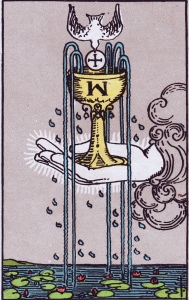
韦特·史密斯塔罗牌中的圣杯首牌形象并非独一无二。
Visconti-Sforza 塔罗牌中的圣杯首牌则是,一个有翅膀的人在一个喷泉之上,泉水从那里流出。
在马赛牌组中,有两个王牌(权杖和剑)有一只从云中出现的手——这是一种标准的中世纪装置,用来表示来自神圣源头的创造、奇迹和礼物。
在下面两张图也有相似之处。第一个是 Wilhelm Hauschild 的 Temple of the Holy Grail (1878),第二张是 Santo Griaal by Rogelio Egusquiza (acquired by the British Museum in 1901)。顺便说一句,如果你和我一样是异教徒,我鼓励你把基督教的参考文献看作是心理隐喻。在这里阅读第1部分。
Hand & Cloud
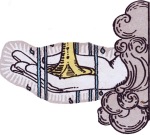
为了显示他的神性,神的手经常被描绘成从一片云层中浮现出来,云层遮住了他的身体,使我们看不到他的力量,因为没有人能看见他,也没有人能活着。因为它是右手,它积极地给予观众在许多文化的神话中发现的四大神圣宝藏之一。在犹太法典中,祝福杯用右手的五个手指托着,代表着保护玫瑰免受荆棘伤害的五片叶子。这幅图像象征着一种超自然景象(云)形式的神圣礼物,通常是精神探索的起点。
Dove & Host
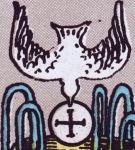
韦特对鸽子有很多话要说,将其描述为保惠师或圣灵的召唤和降临,以更新圣杯的美德并奉献元素。
“在中世纪的英国。圣餐被保留在灵灰安置所,或鸽子房,是一个形状像鸽子的容器。它让人想起一些古老的照片,一只鸽子在上面孵蛋,一只鸽子在草地上降落…
“神秘的鸽子从窗户飞到最里面的神龛,仿佛这只鸟去更新圣洁的美德。”…
“鸽子从天上飞下来,带着拱门的天然宿主,以更新石头的美德[圣杯在一些故事中所采用的形式]。”…“哦,所有圣礼的中心点和神圣的会合点,面包落在酒杯里破碎了,从这两个问题中,都有一个活着的神圣生命精神。”…
“耶稣受难节那天,一只鸽子从天上飞下来,带着神圣的主人。世上所有财富的王冠都得到了更新。”
圣灵 (Holy Spirit) 代表空气赐予生命的精神,它出现在耶稣受水洗礼,觉醒进入新生命时:
耶稣一受洗,就从水里上来了。那时,天开了,他看见神的灵像鸽子降下来,照在他身上。有声音从天上说:“这是我的儿子,我所爱的;我对他很满意。”马可福音1:10-11。
此外,鸽子还与女神维纳斯/阿芙罗狄蒂和爱保持异教联系(韦特在秘密传统中包括了古代异教的秘密)。鸽子拥有超自然的天赋,比如舌头的天赋(如图所示为Yods,见下文),因此它可以与古代的“鸟类语言”或占卜天赋以及奇迹联系在一起。韦特赞同恩典的观点:“是恩典充满了心灵;正是上帝的圣灵使圣灵成为人的圣灵。“恩典,等同于希伯来语的Chesed,是一种祝福,它给予我们指引,保护我们免受世俗力量和逆境的危险。
因此,鸽子可以被视为精神降为肉体,超自然降为自然,这一主题由精神纵轴和物质横轴组成的十字架在主体上重复(十字架代表基督在十字架上的受苦和牺牲,成为一种祝福。)
我应该注意到,大家都知道韦特有着惊人而精确的记忆力。他对语言的使用极其精确,因此,当出现一个奇怪的短语时,通常表示他引用了一个来源来进一步阐明他的意思。互联网使人们有可能找到大量这样的典故。
例如,对韦特来说,host是 "panis quotidianus that has been changed into the panis vivus et vitalis":即日常面包被改变为有生命力的面包。 韦特的这句话指的是托马斯-阿奎那(约1264年)的一首流行赞美诗,叫做《Lauda Sion Salvatorem》。它谈到了圣餐,并介绍了面包和酒的转变,最后以一句熟悉的格言 "as above, so below "结束。
例如,对于韦特来说,host是“panis quotidianus that has been changed into the panis vivus et vitalis”:也就是说,the everyday bread is transformed into a living and vital bread。韦特的这句话引用了托马斯·阿奎那(约1264年)的一首流行赞美诗,名为《圣萨尔瓦多颂》。它谈到了圣餐,并介绍了面包和葡萄酒的转变,以一句熟悉的格言“如上所述,如下所示”结尾:
Living bread, thy life supply:
Strengthen us, or else we die,
Fill us with celestial grace. . . .Thou, who feedest us below:
Source of all we have or know:
Grant that with Thy Saints above,
Sitting at the feast of love,
We may see Thee face to face.Here beneath these signs are hiddenPriceless things, to sense forbidden,
Signs, not things, are all we see. . . .
精神滋养,the Host,是由圣灵差遣的;在许多圣杯故事中,人们发现它可以治愈所有伤口。
Cup, Grail and Fountain of Living Waters
This is the signature image of this card and is filled with meaning on so many levels. We will touch on only a few. As container, it is a major symbol of the receptive feminine and, in Christianity, the womb of the Virgin Mary, the seat of creation and manifestation of Love, esoterically seen as “the Bride”. It is a vessel in which things are “cooked,” making raw materials capable of providing rich nourishment and even, in alchemy, changing lead into gold. It is the cup of transformation containing the waters of life in which water is changed into wine and then into blood. It is the cauldron of Dagda in Celtic myth from which no company ever left unsatisfied.
“The message of the Secret Tradition in the Christian Graal mystery is this: The Cup corresponds to spiritual life. It receives the graces from above and communicates them to that which is below. The equivalent happens in the supernatural Eucharist, the world of unmanifest adeptship, attained by sanctity [Grace].”
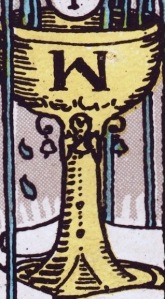
Both cup and water represent the soul.
The Practicus Ritual in Waite’s Fellowship of the Rosy Cross initiates one through an encounter with the Living Waters. First we are informed that Water symbolizes the emotions, desires, and psychic nature of earthly man. But this is not the Water one is to encounter in the ritual, “The Waters that are below desire after the Waters that are above. . . . May the peace of their Union be upon us; be we dissolved therein.”
“The Spirit of God moved upon the face of the Waters, and the Spirit of the Most High God shall move upon the Waters of the Soul. . . . The stilled waters of the soul receive the Spirit of God moving upon the face of its waters. . . . Open thy heart, O Brother of the Rosy Cross, and receive the Water of Life.”
“Fountain of fountains, and of all fountains. Chalice of saving rain. Grace on the soul descending, as rain on the dry grass. Life-giving Rain of Doctrine. Mystical Fruit of the Doctrine. Dew of Divine Speech, falling in stillness on the heart, filling the soul with Knowledge. Enter into the heart and purify; come into the soul and consecrate.”
The image is one of both the Baptismal font and the Eucharist. “A Eucharistic allegory concerns [the dissolution] of the body by Divine Substance communicated to the soul, putting an end to the enchantments and sorceries of the five senses” and to the suffering on the cross (mentioned earlier).
This leads us directly to the five streams coming out of the cup.
Five Streams
Why five streams of water and not the four that Waite specifies in Pictorial Key to the Tarot? Furthermore, Bible readers all know that there are four streams that come out of Eden. This could be an error either on the part of Waite or Pamela Colman Smith. Or, it could veil a secret: These five streams might, after all, represent the five senses (see the quote immediately above), or the five ways of salvation and five gates of grace (from Masonic ritual), or the five wounds of Christ, the five points of the Pentagram, the five petals of the rose that rest on five leaves (the fingers), or the four elements plus aether—the quintessence. In terms of the symbolism, five yields far more relevance according to Waite himself:
“In the Longer Prose Perceval we have seen that there is an account of five changes in the Graal which took place at the altar, being five transfigurations, the last of which assumed the seeming of a chalice, but at the same time, instead of a chalice, was some undeclared mystery: so the general as well as the particular elements of the legend in its highest form offer a mystery the nature of which is recognised by the mystic through certain signs which it carries on its person; yet it is declared in part only and what remains, which is the greater part, is not more than suggested. It is that, I believe, which was seen by the maimed King when he looked into the Sacred Cup and beheld the secret of all things, the beginning even and the end. In this sense the five changes of the Graal are analogous to the five natures of man, as these in their turn correspond to the four aspects of the Cosmos and that which rules all things within and from without the Cosmos.”
I believe that despite their blue color, the five streams best represent blood, for as Marie-Louise von Franz tells us, “Grace was depicted as a fountain of Blood from the five holy wounds of Christ,” The Psychological Meaning of Redemption Motifs in Fairytales.
But it is in Evelyn Underhill, Anglo-Catholic author of a well-known book on mysticism, who perhaps reveals the deepest mystery. Underhill was a student or acolyte of Waite, having joined his branch of the Golden Dawn in 1904 and achieving at least four initiations. She wrote for Waite's Horlick's Magazine and published a novel in 1909 featuring the effects of the Holy Grail on a woman who came into its possession. In an article titled "The Fountain of Life" in the Burlington Magazine (1910) Underhill examined the fountains of water and of blood depicted on several religious works of art including the famous Ghent Altarpiece (right). She notes that baptism and penance which 'renews the grace of baptism,' are still spoken of by Catholic theologians as 'effusions of the Precious Blood,' i.e., of grace. She went on to describe:
“, , , a fountain which is filled by the Blood flowing from the Five Wounds. The Soul, or ‘Bride,’ holds out her heart, and the blood from the wounded side of Christ falls upon it, causing flowers to spring up from the place which has been touched by the vivifying stream. The Precious Blood then . . . stands not merely for an emblem of the Passion, Redemption, or the Eucharist, though it includes all these manifestations of Grace, but for the medium of communication of the Divine Life . . . since for ancient and mediaeval thought the spirit of life resided in the blood.”
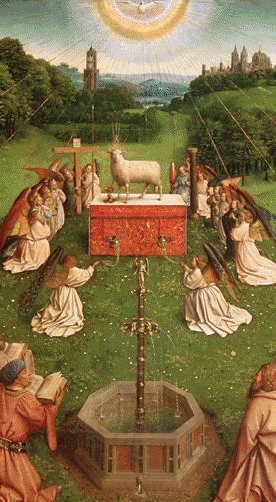
Given that the Aces are also seen by Waite as the four Celtic treasures, I'd be remiss in not presenting this option from Celtic Myth and Religion by Sharon Paice MacLeod:
“In Cormac's Adventures in the Land of Promise, Cormac has a vision of the sacred center of the Otherworld where he saw a shining fountain with five streams flowing out of it. He is told that it is the Fountain of Knowledge [others call it the Well of Wisdom], and the five streams are the five senses through which knowledge is obtained.”
Drops of Dew or Yods
These drops, in the shape of the Hebrew letter Yod are found on many of the Tarot cards, generally signifying divine Grace. Shaped like a flame a Yod is the divine spark of creation that is the foundation of all the other letters and is the first letter in the Tetragrammaton or four-letter name of God. There are 26 yods and Eoin Keith Boyle notes in the comments that this is the sum of the 4-lettered name of God, the Tetragrammaton, in Kabbalistic gematria. They are also the shape of the tongues of fire at Pentecost:
“They saw tongues like flames of a fire that separated and came to rest on each of them. And they were all filled with the Holy Spirit and began to speak in other tongues as the Spirit enabled them.” Acts 2:3-4.
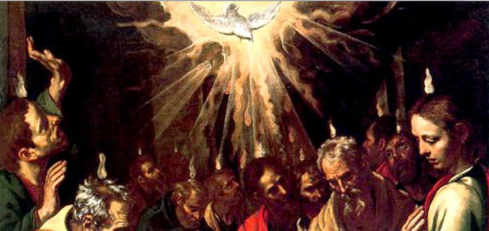
The alchemist Thomas Vaughn, in a compendium by Waite, calls it the divine spark or star-fire that is sympathetically attracted to its origin in God. It is spirit fructifying the soul.
These drops can also be seen as alchemical dew. Thomas Vaughn again explains that divine dew penetrates and transforms all that is physical. Waite claims that for the Rosicrucians “dew is light, coagulated and rendered corporeal. . . . When digested in its own vessel it is the true menstruum of the Red Dragon, i.e., of gold, the true matter of the Philosophers.”
Pool of Water

[In the beginning] “the Spirit of God moved over the face of the waters.” Genesis 1:2.
It is the soul that desires union with the spirit, “The Waters that are below desire after the Waters that are above.”
This is also the generative water of renewal and rebirth. It also represents the emotions which here have become serene and calm, being fed by the waters of the Holy Spirit. In the parlance of Carl Jung it is the rich and fertile pool of the unconscious psyche—the soul. And Evelyn Underhill already explained that the blood from Christ’s wounds causes flowers to spring up—in this case water-lilies that grow only in sweet waters, reaching up from the mud toward the light. Regarding sweet waters, in Waite’s book of aphorisms, Steps to the Crown, we find: “The Cup of bitterness ceases to exist for him who has drunk from the chalice of immortality”.
W or M ?
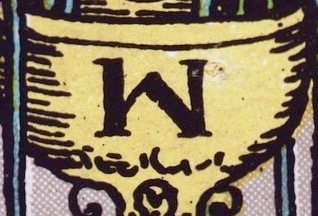
Finally we come to the major controversy associated with this card—What is the significance of the letter on the cup? The fact is that we will never know, but we do have some very likely possibilities, and knowing Waite, all of them may have been what was intended, for Waite saw all symbols as multi-valenced.
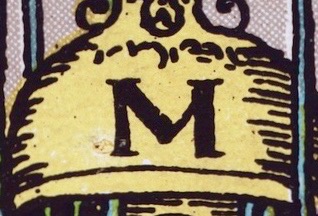
MacGregor Mathers, in his 1888 book Tarot: A Short Treatise on Reading the Cards claims that an inverted M on the front of the Spanish Ace of Cups represented the waters of creation in Genesis and all that remains of an Egyptian motif of twin serpents (as per this 19th century deck reproduced in the Cagliostro Tarot by Modiano of Italy). The Golden Dawn paper on the Tarot, “Book T,” says, “The great Letter of the Supernal Mother is traced in the spray of the Fountain.”
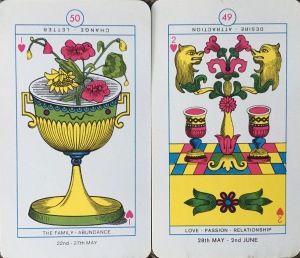
First it is note-worthy that the letter is shaped exactly like Pamela Colman
Smith’s Ms 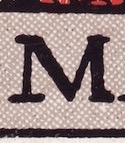 and not like her Ws
and not like her Ws 
The main contenders for W are:
Waite (see the monogram on the Ten of Pentacles)
Water (“the implicit is that the Sign of the Cups naturally refers to water” PKT.)
Womb
Wisdom (more specifically, the Celtic Well of Wisdom)
Woman
The main contenders for M are:
Mystery (“For this is the chalice of my blood, of the new and eternal testament: the Mystery of Faith”).
Mem (or Maim, Hebrew for “water”)
Mary (or Mara, which also means “bitter sea”)
Mother (Matter. As Supernal Mother she is associated with Binah on the Tree of Life and the 2nd letter of the Tetragrammaton, He.)
Mercury (an alchemical maxim: “What wise men seek in Mercury is found”)
I believe that the letter is M and that it stands for Mystery, as viewed from above by the Holy Spirit. It is probably the word Waite uses most in his books where it is usually capitalized. To support this I have found almost this identical summary statement in several of Waite's books:
“[In conclusion] the maxim which might and would be inscribed over the one Temple of the truly Catholic Religion when the faiths of this western world have been united in the higher consciousness–that is assuredly
We might also view the letters like this:
Waite – Mystery
Water – Mem
Womb – Mary/Mother
Wisdom – Mercury
An Act of Imagination
I suggest one final way of getting at the deeper meaning of this card.
Imagine for a moment that you are the Chalice and, perhaps, the liquid in the chalice. Picture yourself reaching up for the host held in the beak of the dove. You might see yourself as a baby bird stretching up to be fed by a parent. Can you experience the yearning? Or you may be a font of water that wells up from a deep source. Feel the draw from above and your yearning toward the source of that draw. Become aware of the wounds gathered through your earthly experience. The water (or blood) within you could begin to spill over, rising up and falling out in a continuous stream. Can you let yourself go, surrender to the movement, and then to gravity so that you fall into the pool beneath? What happens when you spill into that pond? Where do you go? How do you reflect back what is above?
One final characteristic of Cups, which Waite mentions over and over again through his discussion of the suit, is fantasy—the ability to imagine super-sensible things and have experiences of what he calls the Arch-Natural world. While there are dangers in doing so (the Seven of Cups), it is in through mystical experience, first accessed through the door of the imagination, that we are ultimately able to commune with Spirit. I hope to speak more about this in a third post on a Jungian interpretation of this image.

